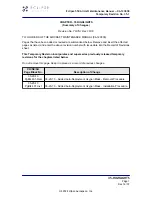
Introduction
Thank you for purchasing your new RRD 5-Line Kite and welcome to the amazing sport
of kiteboarding. While kiteboarding is exciting and easy to learn, it must be approached
safely and with great respect for the equipment and the conditions. This manual is
intended to educate you about your new kite and provide you with information for the
correct set-up, tuning, maintenance and care of the kite and its components. Please
read and understand the manual and safety precautions contained within prior to using
this product. Do not attempt to learn kiteboarding without appropriate instruction.
------------------
1. Release of Liability, Claim Waiver and Assumption of Risk Agreement
By assembling and/or using this RRD Product, you agree that you have read and under-
stood the entire RRD Kiteboarding User's Manual, including all instructions and warnings
contained in that Manual, prior to using the RRD Product in anyway. You additionally
agree that you will ensure any additional or subsequent user of your RRD Product will
read and understand the entire RRD Kiteboarding User's Manual, including all instruc-
tions and warnings contained in that Manual, prior to allowing that person to use your
RRD Kiteboarding Product. If you are unwilling to be bound by such terms, return this
product (before use) for a full refund.
ASSUMPTION OF RISK:
Use of the RRD Product and any of its components involve certain inherent risks, dan-
gers, and hazards, which can result in
serious personal injury and death to both the user and to nonuser third parties. In using
the RRD Product, you freely agree to assume and accept any and all known and
unknown risks of injury to you and to third parties while using this equipment. The risks
inherent in this sport can be greatly reduced by abiding by the warning guidelines listed
in this owner manual and by using common sense.
RELEASE AND WAIVER OF CLAIMS:
In consideration of the sale of the RRD product to you, you hereby agree to the fullest
extent permitted by law, as follows:
TO WAIVE ANY AND ALL CLAIMS that you have or may in the future have against RRD
and all related parties resulting from use of the RRD Product and any of its components.
TO RELEASE RRD and all related parties from any and all liability for any loss, damage,
injury or expense that you or any users of your RRD Product may suffer, or that your
next of kin may suffer, as a result of the use of the RRD Product, due to any cause
whatsoever, including negligence or breach of contract on the part of RRD and all related
parties in the design or manufacture of the RRD Product and any of its components. In
the event of your death or incapacity, all provisions contained herein shall be effective
and binding upon your heirs, next of kin, executors, administrators, assigns, and repre-
sentatives. RRD-related parties have not made and expressly deny any oral or written
representations other than what is set forth herein and the RRD Product User's Manual.
18
3
14. Kite Tuning
Proper tuning is essential for the best performance of your kite. A properly tuned kite
increases its performance, speed, and efficiency,
and allows the kite to de-power and works correctly.
Using the Center Line Power Adjustment System
Tuning the power of a kite can be achieved by changing the lengths of the front and the
back lines using the Power Adjustment System strap. When the kite is at full power
(strap extended), the back (red and green) lines should be tensioned and both steering
speed and power are at a maximum.
If the kite is over-sheeted, (too much tension on the rear lines) however, the
kite will not fly efficiently and will not fly to the edge of the window.
To de-power the kite, the rider pulls in the center strap, shortening the front lines and
slightly slacking the back lines. With too much slack in the back lines, however, steering
will be hindered and the kite will seem slow and unresponsive. How much a rider de-
powers the kite depends on the wind conditions and personal preference.
Adjusting the Turning Speed of the Kite RRD kites come with 2 choices for customizing
the turning speed of your kite. The wingtip is labeled for easy tuning. If a faster
turning kite is desired, move the Fool Proof Connection pigtails to the outer setting labe-
led "faster turns" on both wingtips. If a slower turning is desired, move the Fool Proof
Connection pigtails to the inner setting labeled "slower turns" on both wingtips.
Adjusting the Power of the Kite RRD kites come with 2 power settings to customize
power and lift according to the conditions and rider. The front line connection
points are labeled "more power" and "less power". For more power and lift in underpo-
wered conditions, move the Fool Proof Connection pigtails to the "more power" setting
on both wingtips. For normal power, move the Fool Proof Connection pigtails to the "less
power" setting on both wingtips
Note:
It is important to remember that any changes to the power and speed settings
must be done to both wingtips!
Summary of Contents for 2006 kite
Page 1: ...2006 Kites user s manual...

























